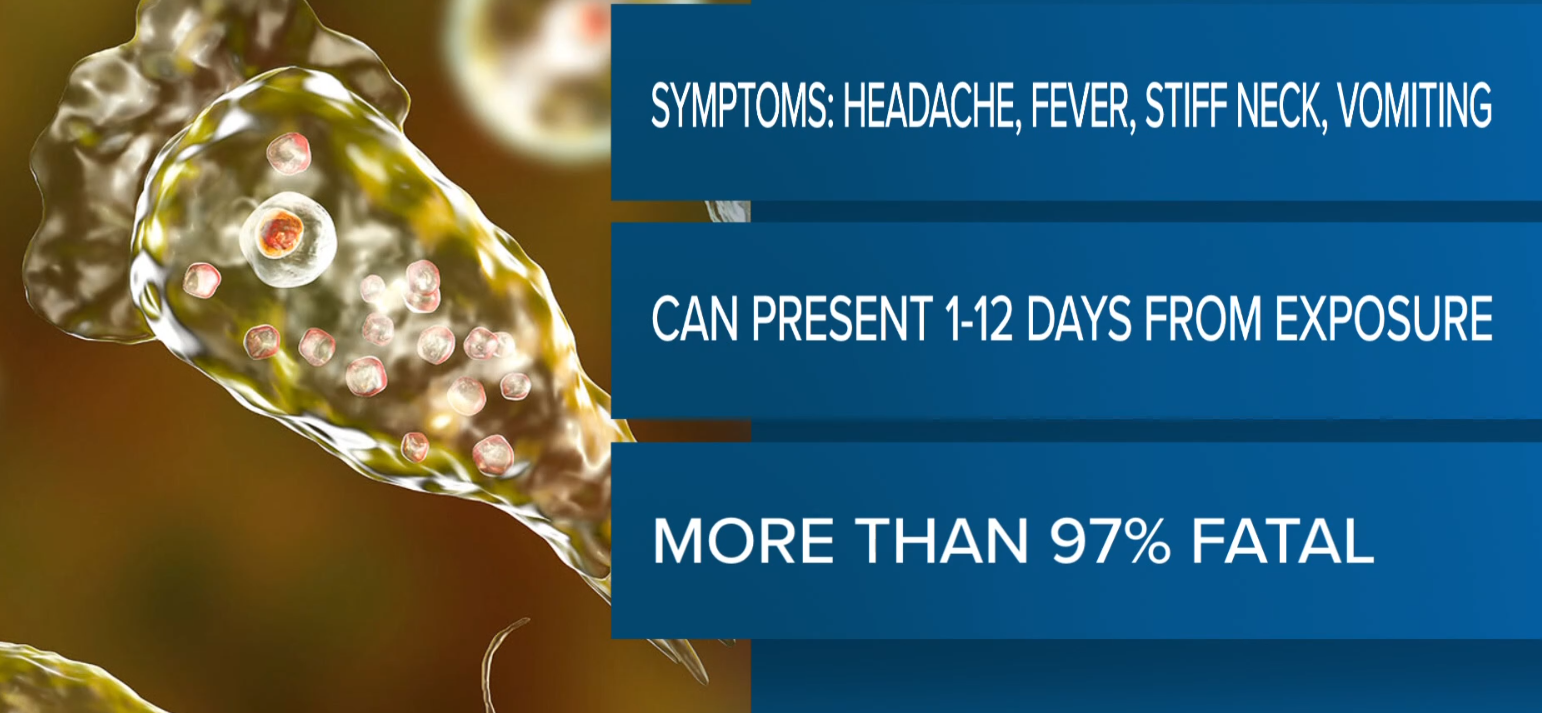COLUMBIA, SC — A pediatric patient treated at Prisma Richland Children’s Hospital in Columbia, South Carolina, has tragically died from a rare but deadly brain-eating amoeba infection. The South Carolina Department of Health and Environmental Control (DHEC) has confirmed that the patient was likely exposed to the amoeba while swimming in Lake Murray, a freshwater lake in the region.
The Infection: A Rare and Dangerous Amoeba
The brain-eating amoeba, known scientifically as Naegleria fowleri, is an organism commonly found in warm freshwater environments such as lakes, rivers, ponds, and other stagnant bodies of water. While rare, the infection it causes is almost always fatal, with a fatality rate of over 97%.
Naegleria fowleri infects people when contaminated water enters the body through the nose, often while swimming or engaging in water activities. Once the amoeba enters the nasal passages, it travels to the brain, where it causes a deadly infection known as primary amoebic meningoencephalitis (PAM). Symptoms of the infection can include headache, fever, stiff neck, vomiting, and other neurological signs. These symptoms usually appear one to 12 days after exposure to the organism.
The Pediatric Death: A Devastating Outcome
The South Carolina Department of Health believes that the young patient contracted the infection after swimming in Lake Murray, although this has not yet been confirmed as the sole source of exposure. The child was immediately treated at Prisma Richland Children’s Hospital upon showing symptoms of the infection. Despite medical intervention, the infection proved fatal, and the patient passed away, marking a deeply saddening moment for the family and medical team involved.
This marks the first reported case of Naegleria fowleri in South Carolina since 2016. While extremely rare, the infection has occurred in other states as well, particularly in warmer regions with lakes and stagnant water sources. The South Carolina Department of Health has been working closely with healthcare providers to ensure proper awareness and monitoring of this dangerous organism, which remains a significant health risk, albeit a rare one.
The State’s Response: Investigating the Source of the Infection
Local health officials have expressed condolences to the grieving family and continue to investigate the source of the infection. Although Lake Murray is suspected as the source of exposure, they are also reminding residents of the ongoing presence of Naegleria fowleri in warm, freshwater environments across the state, particularly in lakes and rivers during the summer months when water temperatures are higher.
While this specific case remains under investigation, authorities are working to ensure public awareness of the potential risks associated with swimming in freshwater lakes and rivers. The Department of Health has also urged swimmers to take extra precautions to avoid infection, particularly in warm, stagnant bodies of water.
Symptoms and Prevention: A Call for Caution
Health professionals have emphasized the importance of recognizing the early symptoms of Naegleria fowleri infection, especially in the aftermath of swimming in warm, freshwater environments. Early symptoms often resemble those of other illnesses, including headaches, fever, nausea, and stiff neck, making diagnosis challenging. If not caught early, the infection can progress quickly to severe neurological damage and death.
While the infection is incredibly rare, experts recommend a few measures to reduce the risk of exposure:
-
Avoiding submerging the head or allowing water to go up the nose while swimming in warm, stagnant freshwater.
-
Using nose plugs or keeping the head above water when swimming in lakes, rivers, or ponds, particularly in warmer months.
-
Using sterile water for any nasal irrigation or cleaning, as tap water may contain trace amounts of the amoeba.
-
Being cautious about swimming in warm, stagnant bodies of water, especially during the hot summer months when water temperatures increase.
The Ongoing Risks: National Cases of Amoeba Infection
The brain-eating amoeba continues to pose a health risk across the United States, with Georgia reporting its most recent case in 2023. 17-year-old Megan Ebenroth died from the infection after swimming in a lake near her home in McDuffie County, Georgia. Megan’s tragic death marked the sixth reported case in Georgia since 1962. These cases are rare, but they underscore the importance of raising awareness about the potential dangers of warm freshwater swimming.
Cases like those of Megan Ebenroth and the recent South Carolina death show that, while rare, Naegleria fowleri is a serious health threat that requires public awareness and education. In particular, young swimmers in freshwater environments may be at higher risk, as they often engage in activities that put them in close contact with the water.
A Call for Increased Awareness
Health experts across the country are calling for increased awareness of the risks associated with Naegleria fowleri, especially in regions with warm freshwater bodies like lakes, rivers, and ponds. They stress the importance of educating the public on the symptoms of the infection and the need for prompt medical care if those symptoms occur after exposure to freshwater.
Both local and state health agencies are reinforcing the message that while the infection is extremely rare, it is still a threat that cannot be ignored. Prisma Richland Children’s Hospital and other healthcare providers are working to ensure that families are informed about how to reduce the risk of infection and are providing resources to help recognize the symptoms of Naegleria fowleri infection in its early stages.
A Community in Mourning
The death of the young patient in South Carolina has left a profound impact on the community, especially among those who knew the family and those who may have swum in Lake Murray or similar water bodies. Community members have expressed their condolences to the family and have called for greater education about water safety and the potential risks of amoeba infections.
The family has requested privacy during this difficult time as they mourn the loss of their loved one, and local officials have offered their support to help them navigate through this tragedy.
Conclusion: Protecting Swimmers and Raising Awareness
This heartbreaking incident serves as a reminder of the unpredictable dangers that can exist in natural water sources, even though the risk of contracting Naegleria fowleri remains extremely low. In response to the recent case, health officials across South Carolina and the broader U.S. are emphasizing the need for increased public education about the brain-eating amoeba and the precautions that can help prevent infection.
As the investigation into the patient’s exposure continues, both public health authorities and healthcare providers are working to ensure that the public is informed about how to protect themselves from this rare but potentially deadly infection. Early detection is critical, and health awareness campaigns will continue to play a vital role in reducing the risks associated with Naegleria fowleri in freshwater environments.
The family’s loss is a reminder of the unpredictable and dangerous elements that exist in nature, but also a catalyst for renewed focus on ensuring safety measures and proper health education surrounding recreational water activities.
This story is developing, and further updates will be provided as more information becomes available.


Leave a Reply